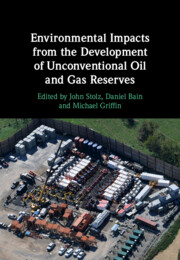Book contents
- Environmental Impacts from the Development of Unconventional Oil and Gas Reserves
- Environmental Impacts from the Development of Unconventional Oil and Gas Reserves
- Copyright page
- Contents
- Figures
- Tables
- Contributors
- Preface
- Part I Overview
- Part II Environmental Analysis
- Part III Case Studies
- 13 Evaluation of Potential Water Quality Impacts in Unconventional Oil and Gas Extraction
- 14 A Baseline Ecological Study of Tributaries in the Tenmile Creek Watershed, Southwest Pennsylvania
- 15 The Effects of Shale Gas Development on Forest Landscapes and Ecosystems in the Appalachian Basin
- 16 Managing TDS and Sulfate in the Monongahela River
- Index
- References
15 - The Effects of Shale Gas Development on Forest Landscapes and Ecosystems in the Appalachian Basin
from Part III - Case Studies
Published online by Cambridge University Press: 28 July 2022
- Environmental Impacts from the Development of Unconventional Oil and Gas Reserves
- Environmental Impacts from the Development of Unconventional Oil and Gas Reserves
- Copyright page
- Contents
- Figures
- Tables
- Contributors
- Preface
- Part I Overview
- Part II Environmental Analysis
- Part III Case Studies
- 13 Evaluation of Potential Water Quality Impacts in Unconventional Oil and Gas Extraction
- 14 A Baseline Ecological Study of Tributaries in the Tenmile Creek Watershed, Southwest Pennsylvania
- 15 The Effects of Shale Gas Development on Forest Landscapes and Ecosystems in the Appalachian Basin
- 16 Managing TDS and Sulfate in the Monongahela River
- Index
- References
Summary
The extensive forests of the Appalachian basin have high ecological value providing critical ecosystem services as well as important habitat for vulnerable species. The Marcellus and Utica shale plays underlay much of this ecosystem, and the overlap between core forest habitat and the shale plays results in an ecosystem that is at high vulnerability to disturbance. We summarize the current extent of development and the documented and predicted effects on the Appalachian forest ecosystem. Development fragments forest habitat and results in loss of core forest primarily as a result of linear infrastructure such as pipelines and roads. USG is associated with higher levels of noise and other disturbance, increased spread of invasive plants and increased risk of contamination to surface water. Future planning and policies should be designed to protect the health and integrity of the core forests of the Appalachian basin by implementing practices to minimize fragmentation, the spread of invasive plants, noise pollution and degradation of water quality and aquatic resources as well as refining techniques for minimizing the overall footprint and implementing site reclamation.
- Type
- Chapter
- Information
- Publisher: Cambridge University PressPrint publication year: 2022



